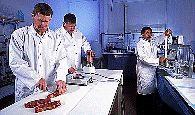United States Department of Agriculture: Agricultural Research Service, Lincoln, Nebraska

Roman L. Hruska U.S. Meat Animal Research Center: Reports
Date of this Version
2015
Document Type
Article
Citation
Proteins: Structure, Function, and Bioinformatics, Article first published online : 18 JAN 2016, DOI: 10.1002/prot.24971
Abstract
Conversion of the primary bile acids cholic acid (CA) and chenodeoxycholic acid (CDCA) to the secondary bile acids deoxycholic acid (DCA) and lithocholic acid (LCA) is performed by a few species of intestinal bacteria in the genus Clostridium through a multistep biochemical pathway that removes a 7a-hydroxyl group. The rate-determining enzyme in this pathway is bile acid 7a-dehydratase (baiE). In this study, crystal structures of apo-BaiE and its putative product-bound [3-oxo-D4,6- lithocholyl-Coenzyme A (CoA)] complex are reported. BaiE is a trimer with a twisted a+b barrel fold with similarity to the Nuclear Transport Factor 2 (NTF2) superfamily. Tyr30, Asp35, and His83 form a catalytic triad that is conserved across this family. Site-directed mutagenesis of BaiE from Clostridium scindens VPI 12708 confirm that these residues are essential for catalysis and also the importance of other conserved residues, Tyr54 and Arg146, which are involved in substrate binding and affect catalytic turnover. Steady-state kinetic studies reveal that the BaiE homologs are able to turn over 3-oxo-D4-bile acid and CoA-conjugated 3-oxo-D4-bile acid substrates with comparable efficiency questioning the role of CoA-conjugation in the bile acid metabolism pathway.


Comments
U. S. government work.